Cover
Half-title
Title
Copyright
Contents
Table of Notation
Preface
1 Boolean retrieval
1.1 An example information retrieval problem
1.2 A first take at building an inverted index
1.3 Processing Boolean queries
1.4 The extended Boolean model versus ranked retrieval
1.5 References and further reading
2 The term vocabulary and postings lists
2.1 Document delineation and character sequence decoding
2.1.1 Obtaining the character sequence in a document
2.1.2 Choosing a document unit
2.2 Determining the vocabulary of terms
2.2.1 Tokenization
2.2.2 Dropping common terms: stop words
2.2.3 Normalization (equivalence classing of terms)
2.2.4 Stemming and lemmatization
2.3 Faster postings list intersection via skip pointers
2.4 Positional postings and phrase queries
2.4.1 Biword indexes
2.4.2 Positional indexes
2.4.3 Combination schemes
2.5 References and further reading
3 Dictionaries and tolerant retrieval
3.1 Search structures for dictionaries
3.2 Wildcard queries
3.2.1 General wildcard queries
3.2.2 k-gram indexes for wildcard queries
3.3 Spelling correction
3.3.1 Implementing spelling correction
3.3.2 Forms of spelling correction
3.3.3 Edit distance
3.3.4 k-gram indexes for spelling correction
3.3.5 Context-sensitive spelling correction
3.4 Phonetic correction
3.5 References and further reading
4 Index construction
4.1 Hardware basics
4.2 Blocked sort-based indexing
4.3 Single-pass in-memory indexing
4.4 Distributed indexing
4.5 Dynamic indexing
4.6 Other types of indexes
4.7 References and further reading
5 Index compression
5.1 Statistical properties of terms in information retrieval
5.1.1 Heaps' law: Estimating the number of terms
5.1.2 Zipf's law: Modeling the distribution of terms
5.2 Dictionary compression
5.2.1 Dictionary as a string
5.2.2 Blocked storage
5.3 Postings file compression
5.3.1 Variable byte codes
5.3.2 Gamma codes
5.4 References and further reading
6 Scoring, term weighting, and the vector space model
6.1 Parametric and zone indexes
6.1.1 Weighted zone scoring
6.1.2 Learning weights
6.1.3 The optimal weight g
6.2 Term frequency and weighting
6.2.1 Inverse document frequency
6.2.2 Tf--idf weighting
6.3 The vector space model for scoring
6.3.1 Dot products
6.3.2 Queries as vectors
6.3.3 Computing vector scores
6.4 Variant tf--idf functions
6.4.1 Sublinear tf scaling
6.4.2 Maximum tf normalization
6.4.3 Document and query weighting schemes
6.4.4 Pivoted normalized document length
6.5 References and further reading
7 Computing scores in a complete search system
7.1 Efficient scoring and ranking
7.1.1 Inexact top K document retrieval
7.1.2 Index elimination
7.1.3 Champion lists
7.1.4 Static quality scores and ordering
7.1.5 Impact ordering
7.1.6 Cluster pruning
7.2 Components of an information retrieval system
7.2.1 Tiered indexes
7.2.2 Query term proximity
7.2.3 Designing parsing and scoring functions
7.2.4 Putting it all together
7.3 Vector space scoring and query operator interaction
7.4 References and further reading
8 Evaluation in information retrieval
8.1 Information retrieval system evaluation
8.2 Standard test collections
8.3 Evaluation of unranked retrieval sets
8.4 Evaluation of ranked retrieval results
8.5 Assessing relevance
8.5.1 Critiques and justifications of the concept of relevance
8.6 A broader perspective: System quality and user utility
8.6.1 System issues
8.6.2 User utility
8.6.3 Refining a deployed system
8.7 Results snippets
8.8 References and further reading
9 Relevance feedback and query expansion
9.1 Relevance feedback and pseudo relevancefeedback
9.1.1 The Rocchio algorithm for relevance feedback
9.1.2 Probabilistic relevance feedback
9.1.3 When does relevance feedback work?
9.1.4 Relevance feedback on the web
9.1.5 Evaluation of relevance feedback strategies
9.1.6 Pseudo relevance feedback
9.1.7 Indirect relevance feedback
9.1.8 Summary
9.2 Global methods for query reformulation
9.2.1 Vocabulary tools for query reformulation
9.2.2 Query expansion
9.2.3 Automatic thesaurus generation
9.3 References and further reading
10 XML retrieval
10.1 Basic XML concepts
10.2 Challenges in XML retrieval
10.3 A vector space model for XML retrieval
10.4 Evaluation of XML retrieval
10.5 Text-centric versus data-centric XML retrieval
10.6 References and further reading
11 Probabilistic information retrieval
11.1 Review of basic probability theory
11.2 The probability ranking principle
11.2.1 The 1/0 loss case
11.2.2 The probability ranking principle with retrieval costs
11.3 The binary independence model
11.3.1 Deriving a ranking function for query terms
11.3.2 Probability estimates in theory
11.3.3 Probability estimates in practice
11.3.4 Probabilistic approaches to relevance feedback
11.4 An appraisal and some extensions
11.4.1 An appraisal of probabilistic models
11.4.2 Tree-structured dependencies between terms
11.4.3 Okapi BM25: A nonbinary model
11.4.4 Bayesian network approaches to information retrieval
11.5 References and further reading
12 Language models for information retrieval
12.1 Language models
12.1.1 Finite automata and language models
12.1.2 Types of language models
12.1.3 Multinomial distributions over words
12.2 The query likelihood model
12.2.1 Using query likelihood language models in IR
12.2.2 Estimating the query generation probability
12.2.3 Ponte and Croft's experiments
12.3 Language modeling versus other approachesin information retrieval
12.4 Extended language modeling approaches
12.5 References and further reading
13 Text classification and Naive Bayes
13.1 The text classification problem
13.2 Naive Bayes text classification
13.2.1 Relation to multinomial unigram language model
13.3 The Bernoulli model
13.4 Properties of Naive Bayes
13.4.1 A variant of the multinomial model
13.5 Feature selection
13.5.1 Mutual information
13.5.2 Chi2 Feature selection
13.5.3 Frequency-based feature selection
13.5.4 Feature selection for multiple classifiers
13.5.5 Comparison of feature selection methods
13.6 Evaluation of text classification
13.7 References and further reading
14 Vector space classification
14.1 Document representations and measures of relatedness in vector spaces
14.2 Rocchio classification
14.3 k nearest neighbor
14.3.1 Time complexity and optimality of k nearest neighbor
14.4 Linear versus nonlinear classifiers
14.5 Classification with more than two classes
14.6 The bias--variance tradeoff
14.7 References and further reading
15 Support vector machines and machine learning on documents
15.1 Support vector machines: The linearly separable case
15.2 Extensions to the support vector machine model
15.2.1 Soft margin classification
15.2.2 Multiclass support vector machines
15.2.3 Nonlinear support vector machines
15.2.4 Experimental results
15.3 Issues in the classification of text documents
15.3.1 Choosing what kind of classifier to use
15.3.2 Improving classifier performance
15.4 Machine-learning methods in ad hoc information retrieval
15.4.1 A simple example of machine-learned scoring
15.4.2 Result ranking by machine learning
15.5 References and further reading
16 Flat clustering
16.1 Clustering in information retrieval
16.2 Problem statement
16.2.1 Cardinality -- The number of clusters
16.3 Evaluation of clustering
16.4 K-means
16.4.1 Cluster cardinality in K-means
16.5 Model-based clustering
16.6 References and further reading
17 Hierarchical clustering
17.1 Hierarchical agglomerative clustering
17.2 Single-link and complete-link clustering
17.2.1 Time complexity
17.3 Group-average agglomerative clustering
17.4 Centroid clustering
17.5 Optimality of hierarchical agglomerative clustering
17.6 Divisive clustering
17.7 Cluster labeling
17.8 Implementation notes
17.9 References and further reading
18 Matrix decompositions and latent semantic indexing
18.1 Linear algebra review
18.1.1 Matrix decompositions
18.2 Term--document matrices and singular value decompositions
18.3 Low-rank approximations
18.4 Latent semantic indexing
18.5 References and further reading
19 Web search basics
19.1 Background and history
19.2 Web characteristics
19.2.1 The web graph
19.2.2 Spam
19.3 Advertising as the economic model
19.4 The search user experience
19.4.1 User query needs
19.5 Index size and estimation
19.6 Near-duplicates and shingling
19.7 References and further reading
20 Web crawling and indexes
20.1 Overview
20.1.1 Features a crawler must provide
20.1.2 Features a crawler should provide
20.2 Crawling
20.2.1 Crawler architecture
20.2.2 DNS resolution
20.2.3 The URL frontier
20.3 Distributing indexes
20.4 Connectivity servers
20.5 References and further reading
21 Link analysis
21.1 The Web as a graph
21.1.1 Anchor text and the web graph
21.2 PageRank
21.2.1 Markov chains
21.2.2 The PageRank computation
21.2.3 Topic-specific PageRank
21.3 Hubs and authorities
21.3.1 Choosing the subset of the Web
21.4 References and further reading
Bibliography
Index
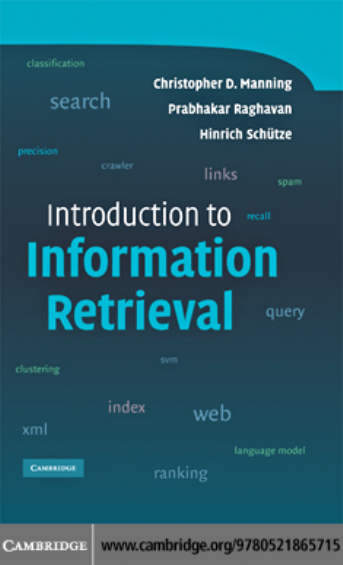

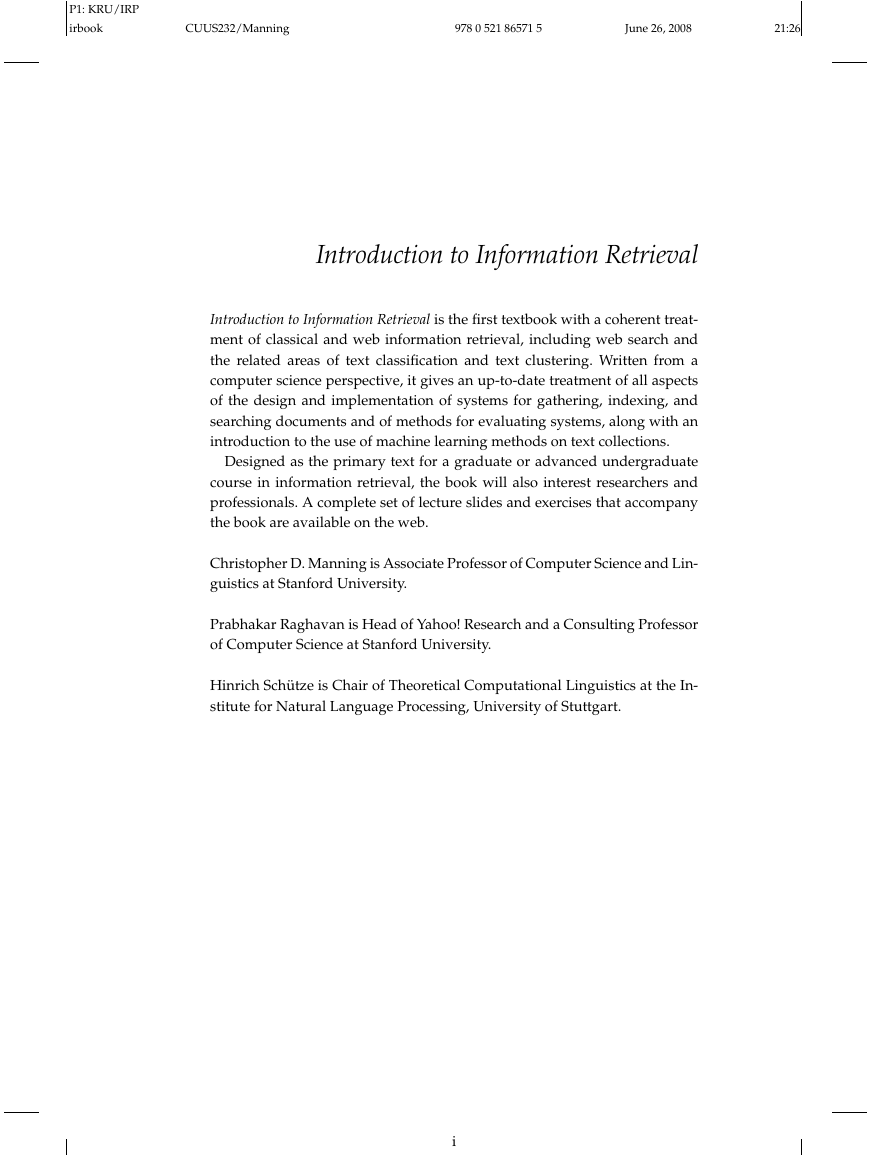

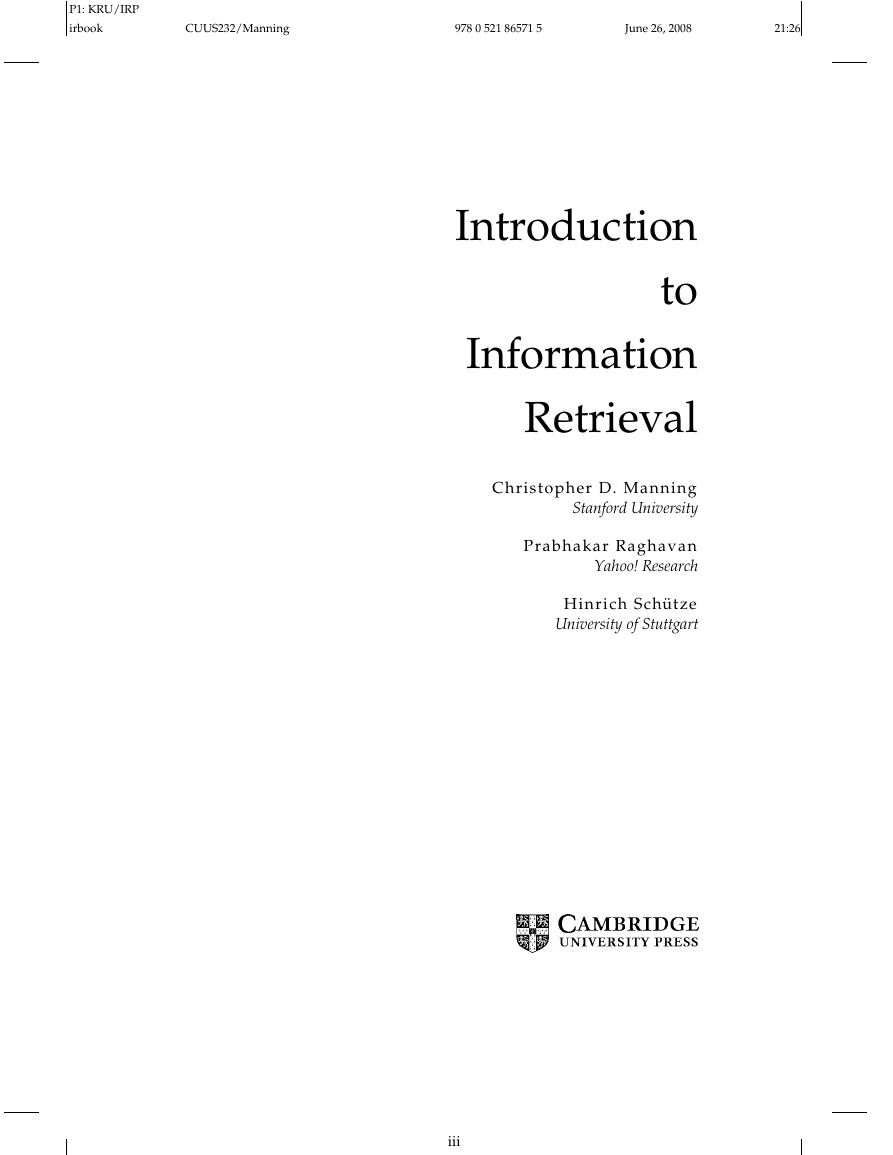
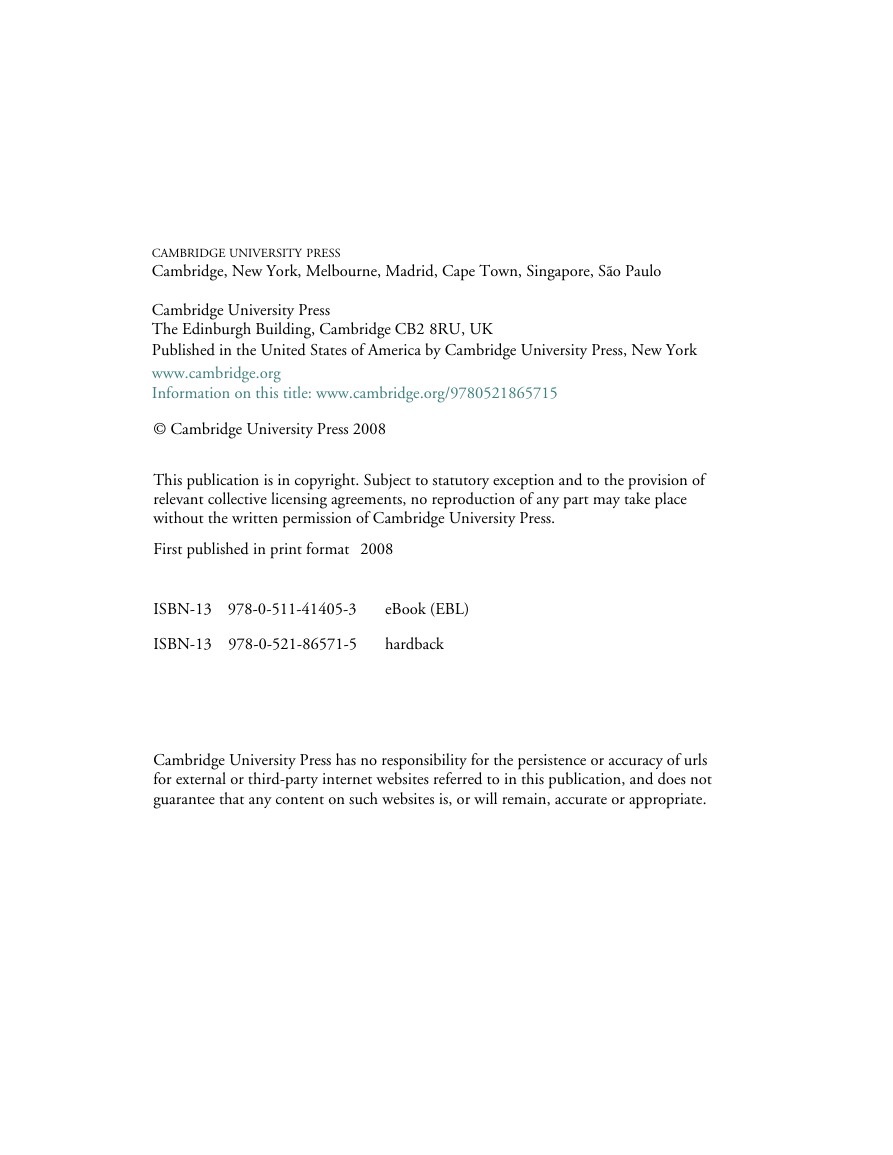
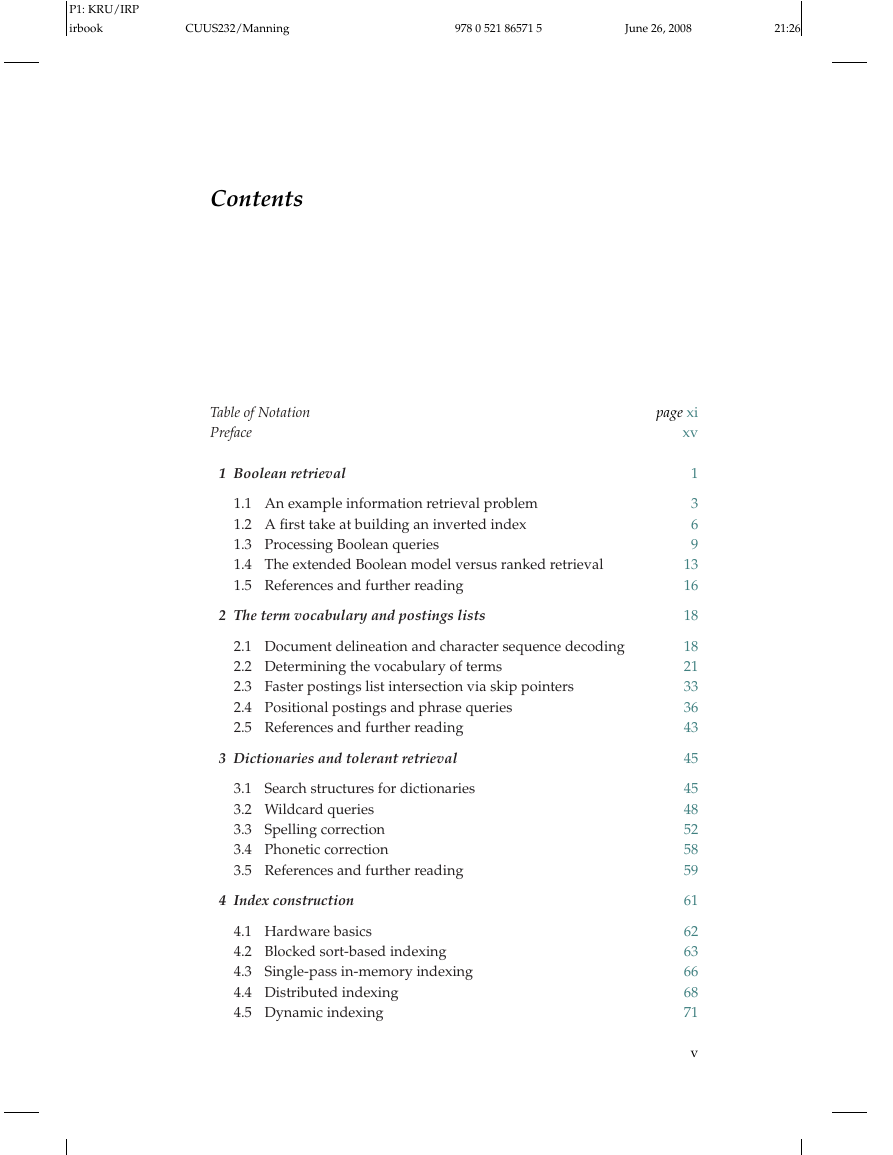
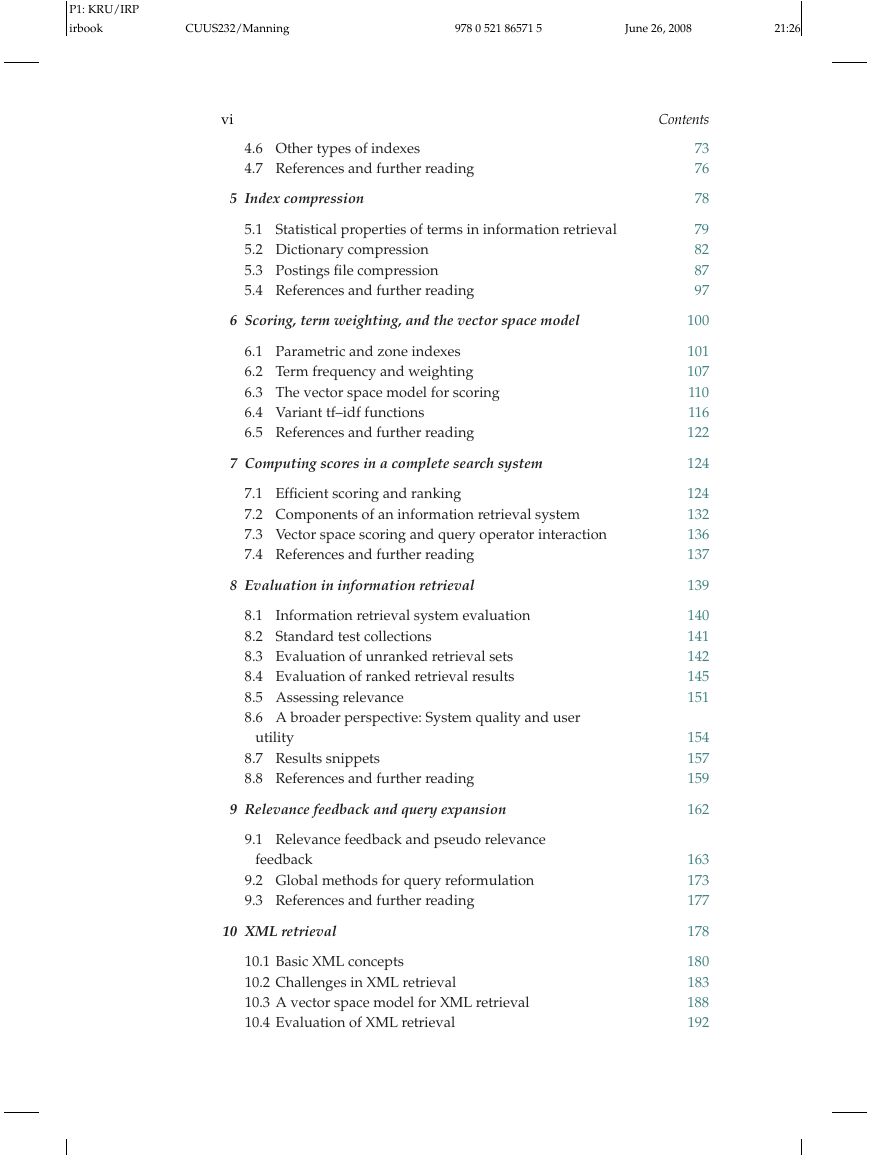








 2023年江西萍乡中考道德与法治真题及答案.doc
2023年江西萍乡中考道德与法治真题及答案.doc 2012年重庆南川中考生物真题及答案.doc
2012年重庆南川中考生物真题及答案.doc 2013年江西师范大学地理学综合及文艺理论基础考研真题.doc
2013年江西师范大学地理学综合及文艺理论基础考研真题.doc 2020年四川甘孜小升初语文真题及答案I卷.doc
2020年四川甘孜小升初语文真题及答案I卷.doc 2020年注册岩土工程师专业基础考试真题及答案.doc
2020年注册岩土工程师专业基础考试真题及答案.doc 2023-2024学年福建省厦门市九年级上学期数学月考试题及答案.doc
2023-2024学年福建省厦门市九年级上学期数学月考试题及答案.doc 2021-2022学年辽宁省沈阳市大东区九年级上学期语文期末试题及答案.doc
2021-2022学年辽宁省沈阳市大东区九年级上学期语文期末试题及答案.doc 2022-2023学年北京东城区初三第一学期物理期末试卷及答案.doc
2022-2023学年北京东城区初三第一学期物理期末试卷及答案.doc 2018上半年江西教师资格初中地理学科知识与教学能力真题及答案.doc
2018上半年江西教师资格初中地理学科知识与教学能力真题及答案.doc 2012年河北国家公务员申论考试真题及答案-省级.doc
2012年河北国家公务员申论考试真题及答案-省级.doc 2020-2021学年江苏省扬州市江都区邵樊片九年级上学期数学第一次质量检测试题及答案.doc
2020-2021学年江苏省扬州市江都区邵樊片九年级上学期数学第一次质量检测试题及答案.doc 2022下半年黑龙江教师资格证中学综合素质真题及答案.doc
2022下半年黑龙江教师资格证中学综合素质真题及答案.doc